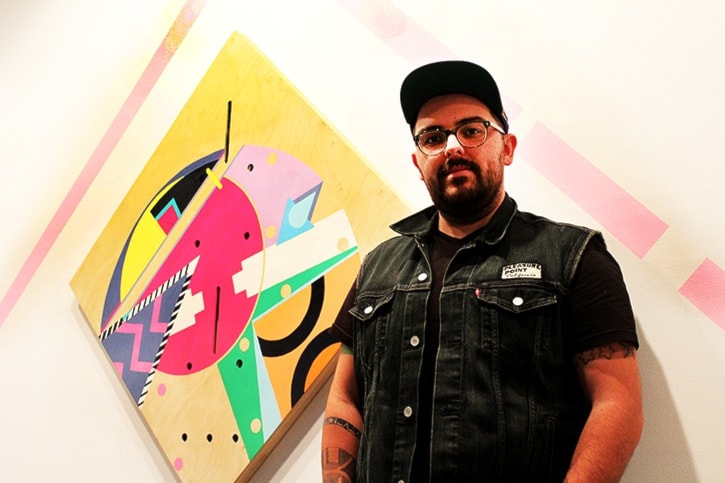It sounds like white noise at first.
The hum vibrates and then changes into the crackle of fire and the rush of water as you approach the brightly coloured piece on the wall.
What looks like a circular conglomeration of geometrical lines and shapes comes to life upon closer inspection. Inlaid on carved yellow cedar are intricately painted symbols and designs relating to the first peoples from the far off island of Newfoundland.
This is Jordan Bennett’s Mniku, or island, as told in the language of Bennett’s ancestors, the Mi’kmaq, which is currently on exhibition at the Vernon Public Art Gallery.
“You know about who you are the longer you spend the time and stay with the piece,” says Bennett, as his reason for installing sound to his first solo exhibition of this particular work. “If you don’t get close, you’ll just hear static.”
Mniku is Bennett’s way to bring back the practices, both contemporary and historical, of not only the Mi’kmaq, but also of the Beothuk, who were indigenous to Newfoundland before becoming extinct around the time of European settlement in the early-1800s.
He does this through a contemporary indigenous lens.
“It’s an homage to both the visual motifs of both and a way to make the space exist for them again. Each piece acts as its own island,” said Bennett.
Originally from Stephenville Crossing on the west coast of the Rock, Bennett is now in his second and final year of completing his master of fine arts degree at UBC Okanagan.
Already an established artist, who was awarded the Newfoundland and Labrador Arts Councils Artist of the Year and named as one of the artists in the 2014 Blouin ARTINFO’s Top 30 under 30 in Canada, Bennett last showed his work at the VPAG in Decolonize Me, a group exhibition on First Nations contemporary art that was organized by the Ottawa Art Gallery.
Mniku is Bennett’s master’s thesis exhibition.
To create the work, Bennett conducted extensive research that not only took him to museums, art galleries and archives around the country, but also to his homeland.
For example, the water and fire heard in his sound installation, which is triggered by movement, was recorded on a visit to the Exploits River that flows through the central part of Newfoundland.
“We also went moose hunting to a place called Big Pond, which was a meeting place between the Beothuk and the Mi’kmaq,” said Bennett.
“People say the Mi’kmaq were not originally part of Newfoundland. The history is very convoluted. Most of my people put written history aside and rely on the oral accounts.”
In a way to counteract with the natural side, Bennett recorded the ambient sound, actually the hum of air conditioning, while observing historical drawings at The Rooms collections and archives in St. John’s.
All this leads the viewer closer to the art on the walls.
“It took quite a while to balance both Beothuk and Mi’kmaq designs. I wanted to look at the relationship on how the two function together,” said Bennett. “There’s lots of symbolism here. Some are known, some are not. My goal is to give them new life... a place to breathe again.”
 Bennett’s first piece, a sampler called Hunt Guide in Red Cedar, plays with the designs and shapes of putting the Beothuk and Mi’kmaq together. Its name comes from the Hunt family, including Bradley Hunt, who is a master carver from Sechelt on the Sunshine Coast, who opened his studio to Bennett so he could study carving techniques using hand tools.
Bennett’s first piece, a sampler called Hunt Guide in Red Cedar, plays with the designs and shapes of putting the Beothuk and Mi’kmaq together. Its name comes from the Hunt family, including Bradley Hunt, who is a master carver from Sechelt on the Sunshine Coast, who opened his studio to Bennett so he could study carving techniques using hand tools.
There is another West Coast angle to Bennett’s work. He sourced the yellow cedar from a sawmill up the coast.
“We suspect the wood came from Bella Bella or Haida Gwaii from a tree that was 1,000 years old. The sawmill is run by friends of mine who give the community first choice of what they cut,” said Bennett.
The vibrant, neon-like acrylic painted intricate patterns on the wood comes from porcupine quills the Mi’kmaq used to embed in baskets and boxes.
“I took time to look at the patterns of my culture to create this sort of fifth dimension,” said Bennett. “This is my interpretation of my people. If they had these colours in the day, they would have used them. Indigenous art was contemporary for the times.”
While another one of Bennett’s pieces shows the belly of a pond, trout eggs and a fish ladder, other shapes and patterns, including drilled holes into the wood surface, are influenced by found objects, such as flat bone carvings and pendants, which were uncovered in burial sites of the Beothuk.
These influences can also be seen in the drawings done by a woman named Shanawdithit, who was the last known Beothuk to live before succumbing to tuberculosis in 1829 at the approximate age of 29.
“She is renowned in Newfoundland and was taken from her home to St. John’s to work as a house maid,” said Bennett, who has some of her drawings tattooed on his arms.
Bennett’s own drawings and smaller paintings on paper, to show his creative process, are also part of Mniku.
“This is just the beginning of a lifetime of work for me,” said Bennett, who next travels to Campbelltown, Australia to show his work.
Mniku can now be viewed at the VPAG from now to May 18. More information is available at vernonpublicartgallery.com or call 250-545-3173.
